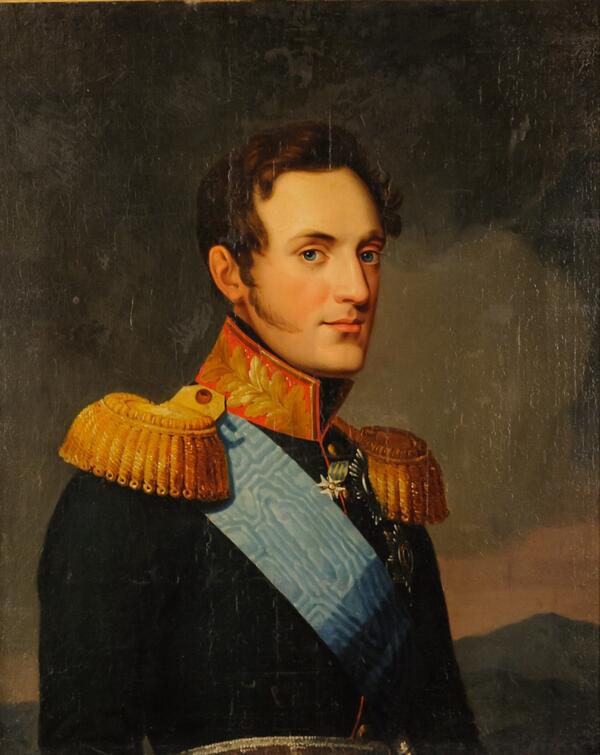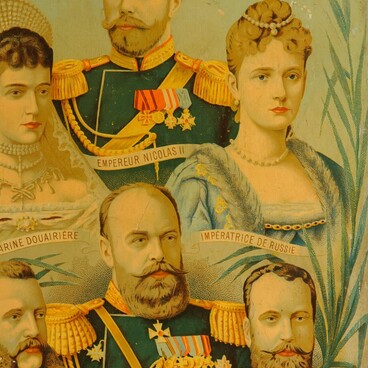This shoulder-length portrait of young Nicholas I (b. 1796 – d.1855) is a copy from a work by George Dawe (b.1781 – d. 1829), a famous English portrait painter, honorary member of the Academies of Fine Arts of London, Florence, Dresden and Stockholm. Dawe came to Saint Petersburg in 1819 at the invitation of Emperor Alexander I, who commissioned portraits of Russian generals who took part in the Patriotic war of 1812 against Napoleon (these portraits are now exhibited in the Military Gallery of the Winter Palace). In 1820, Dawe was promoted to a Free Honorary Member of the Imperial Academy of Fine Arts in Saint Petersburg. Dawe’s works were immensely popular and extensively copied.
The copy of the portrait of Nicholas I (at the time when it was painted, he was still Grand Duke Nicholas) has been exhibited in the State Rooms of Massandra palace since 1992.
The sky serves as the background for this shoulder-length portrait. The Grand Duke is portrayed from three-quarter, with his right shoulder turned to the viewer. The sitter wears sideburns and his dark hair is curled and combed over the temples according to the fashion of the period. He is wearing a full-dress uniform with a red high-neck collar embroidered with gold thread and golden epaulettes on his shoulders.
The sitter is wearing several insignia.
One is the Order of St. Andrew – the highest order of the Russian Empire, established by Emperor Peter the Great. According to the law passed by Emperor Paul I, all Grand Dukes were entitled to it at birth and were awarded with it at their christening ceremony.
Along with the Order of St. Andrew, Grand Dukes were awarded with three lower orders of the Russian Empire: Imperial Order of Saint Alexander Nevsky, Order of the White Eagle, and Order of Saint Anna, first class.
The Order of Saint Vladimir was bestowed to Grand Duke Nicholas in December 1823 when he was 27. This order was established by Empress Catherine the Great at the 20th anniversary of her reign and was awarded for military or civil service.
Grand Duke Nicholas also received the Swedish Order of the Sword, which was bestowed to him to celebrate the Russian-Swedish alliance in the war effort against Napoleon. The Order had been established by King Frederik I, to be awarded to the ones who had distinguished themselves in battle.
The copy of the portrait of Nicholas I (at the time when it was painted, he was still Grand Duke Nicholas) has been exhibited in the State Rooms of Massandra palace since 1992.
The sky serves as the background for this shoulder-length portrait. The Grand Duke is portrayed from three-quarter, with his right shoulder turned to the viewer. The sitter wears sideburns and his dark hair is curled and combed over the temples according to the fashion of the period. He is wearing a full-dress uniform with a red high-neck collar embroidered with gold thread and golden epaulettes on his shoulders.
The sitter is wearing several insignia.
One is the Order of St. Andrew – the highest order of the Russian Empire, established by Emperor Peter the Great. According to the law passed by Emperor Paul I, all Grand Dukes were entitled to it at birth and were awarded with it at their christening ceremony.
Along with the Order of St. Andrew, Grand Dukes were awarded with three lower orders of the Russian Empire: Imperial Order of Saint Alexander Nevsky, Order of the White Eagle, and Order of Saint Anna, first class.
The Order of Saint Vladimir was bestowed to Grand Duke Nicholas in December 1823 when he was 27. This order was established by Empress Catherine the Great at the 20th anniversary of her reign and was awarded for military or civil service.
Grand Duke Nicholas also received the Swedish Order of the Sword, which was bestowed to him to celebrate the Russian-Swedish alliance in the war effort against Napoleon. The Order had been established by King Frederik I, to be awarded to the ones who had distinguished themselves in battle.



